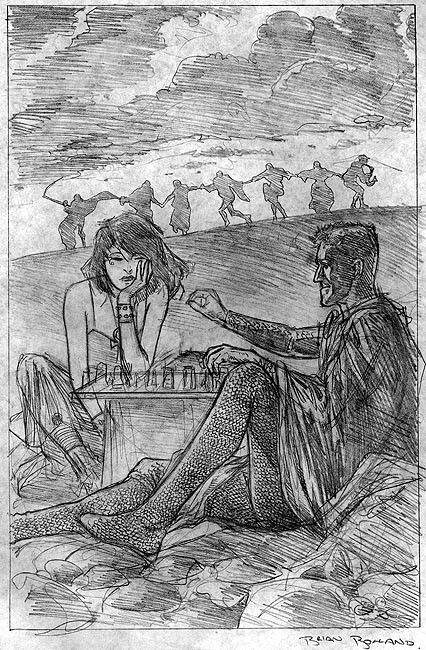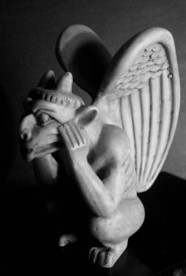I feel a bit embarrassed about yesterday's post, which was in some ways just an excuse to post two of my favourite comic panels ever. Embarrassed? Well, yes. You see, these are just panels, when you get down to it; no matter how brilliantly they're composed and executed they're not intended to stand alone. They're not comics - they're parts of comics.
(To be fair, the panel from Ed the Happy Clown is in some senses a comic in its own right, at least if you accept Scott McCloud's definition of comics - as I do in principle - but that's a separate discussion, and one I'll look forward to getting into soon.)
For all that, though, if you've been intrigued by how different and yet remarkable the panels by Brown and Sienkiewicz are you may have been tempted to follow the link to what is almost certainly the most famous panel Brian Bolland ever drew in his time working for 2000AD. As far as I can recall it won a poll a few years back when readers were asked to vote for their favourite 2000AD panel ever, and Warren Ellis declares it the greatest comics panel of all time. So there.

To be fair, 2000AD's most iconic panel is explosive enough in isolation, but to really get its full impact you need to see it in context - read a couple of episodes leading up to this, or at least the two pages leading up to and following this.
And then go and buy Judge Dredd Case Files, No. 5, because it contains not just this story but also the epic that was 'The Apocalypse War'.
And marvel, when you do, that those breathtaking Brian Bolland illustrations in 'Judge Death Lives' and 'Block Mania' were all done with a brush. Not a pen. A brush. I learned that from an interview with him in a 2000AD annual when I was a kid - I learned much else about him besides, notably that he had a human skull on a shelf in his studio, which he would grin up at from time to time and address as 'Uncle'.
All of which is a decidedly cumbersome way of leading you towards Brian Bolland's website, which I stumbled upon last night. There's some fantastic stuff there, not least his lessons section, where this master of the brush explains how he constantly manages to pull off the same trick on his computer.
(To be fair, the panel from Ed the Happy Clown is in some senses a comic in its own right, at least if you accept Scott McCloud's definition of comics - as I do in principle - but that's a separate discussion, and one I'll look forward to getting into soon.)
For all that, though, if you've been intrigued by how different and yet remarkable the panels by Brown and Sienkiewicz are you may have been tempted to follow the link to what is almost certainly the most famous panel Brian Bolland ever drew in his time working for 2000AD. As far as I can recall it won a poll a few years back when readers were asked to vote for their favourite 2000AD panel ever, and Warren Ellis declares it the greatest comics panel of all time. So there.

To be fair, 2000AD's most iconic panel is explosive enough in isolation, but to really get its full impact you need to see it in context - read a couple of episodes leading up to this, or at least the two pages leading up to and following this.
And then go and buy Judge Dredd Case Files, No. 5, because it contains not just this story but also the epic that was 'The Apocalypse War'.
And marvel, when you do, that those breathtaking Brian Bolland illustrations in 'Judge Death Lives' and 'Block Mania' were all done with a brush. Not a pen. A brush. I learned that from an interview with him in a 2000AD annual when I was a kid - I learned much else about him besides, notably that he had a human skull on a shelf in his studio, which he would grin up at from time to time and address as 'Uncle'.
All of which is a decidedly cumbersome way of leading you towards Brian Bolland's website, which I stumbled upon last night. There's some fantastic stuff there, not least his lessons section, where this master of the brush explains how he constantly manages to pull off the same trick on his computer.
 In the gallery section there's a lovely sketch which I first saw in Bolland's portfolio at a convention years ago. It was an idea, ultimately discarded, for 1994's Death Gallery, a DC Comics collection under its Vertigo imprint of a series of stand-alone paintings and drawings of Neil Gaiman's Death.
In the gallery section there's a lovely sketch which I first saw in Bolland's portfolio at a convention years ago. It was an idea, ultimately discarded, for 1994's Death Gallery, a DC Comics collection under its Vertigo imprint of a series of stand-alone paintings and drawings of Neil Gaiman's Death.No, not his death. His Death. The sister of Dream? The second of the Endless? From The Sandman? Oh, look it up. I told a friend about her today, describing her as a very cute, very sexy, very smart, and very sensible Goth girl; her response was to remark that she looked cool and wanted her to be her friend. Oddly, that's not too far from what Neil Gaiman had in mind when he created her: he wanted the kind of death he'd like to meet, someone nice and sensible, rather than someone bleak and forbidding, like Terry Pratchett's, say, or Ingmar Bergman's.
Which brings me back to my point. In the end, Brian Bolland's contribution to the Death Gallery was a picture that, well, although professional and polished like everything Brian does, lacks the wit and charm of the idea he'd discarded.
Ah well. I wonder if the original is for sale...

No comments:
Post a Comment